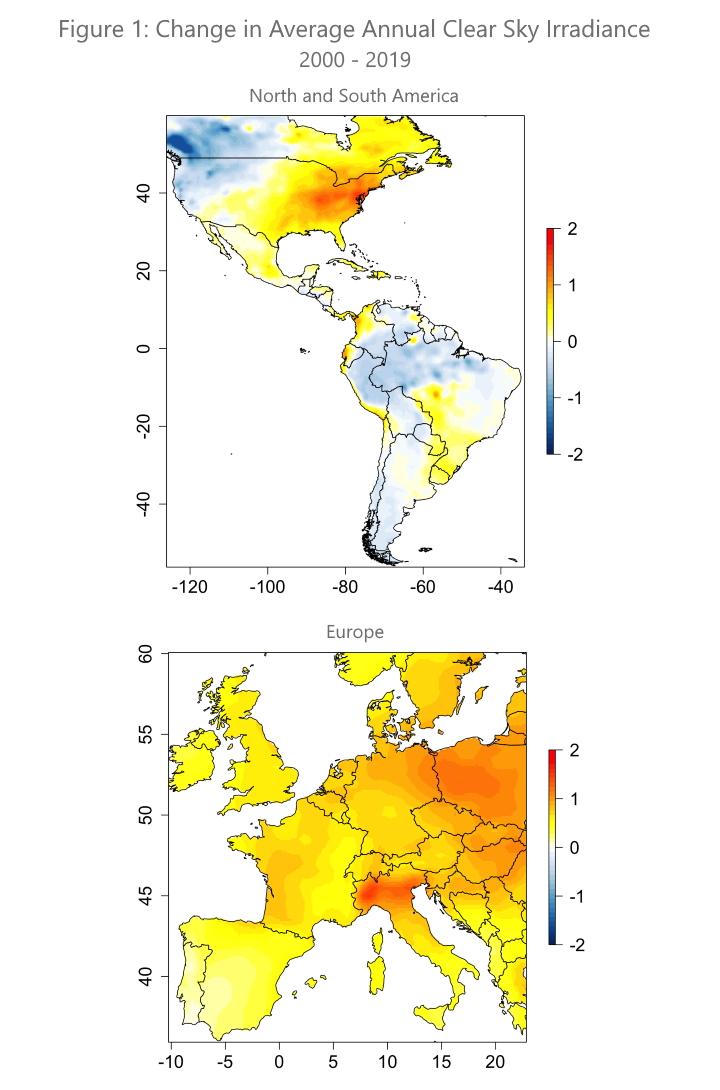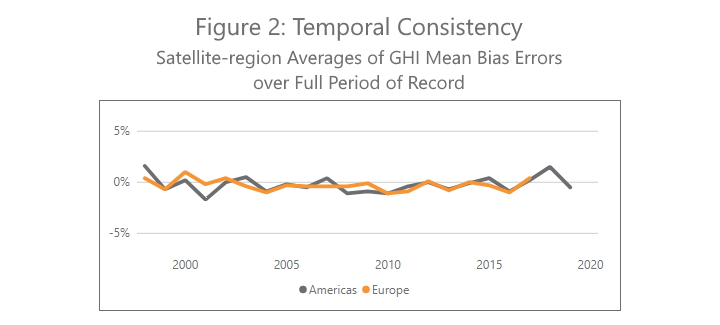In many regions around the world, the skies are getting cleaner thanks to controls on air pollution designed to benefit public health. The Eastern U.S. and Europe have seen dramatic improvements in air quality since the 1980s. Coal plant retirements and stricter regulations on emissions from cars and factories have reduced particulate matter in the air. The Environmental Protection Agency found that people are living longer, healthier lives as a result of tighter emissions standards.
An additional benefit is increased solar production. Air pollution disperses sunlight and reflects some of it back into space. Removing pollution increases the sunlight reaching the earth’s surface. That increases the output of solar power plants, which in turn increases solar project value.
The amount of sunlight hitting the ground on a clear day has increased almost two percent since the year 2000 in regions of the U.S. and Europe.

In the Western U.S., however, the trend is flat. A lower level of pollution to start with, and an increase in wildfires may explain the trend.
The value of a solar project today depends on its future energy production. In practice the solar industry uses historical data to estimate the future solar resource. This works because changes in climate occur over decades, not years.
But for long-term owners, these changes matter. Repowering and increased system reliability promise to extend the usable life of projects beyond 30 years and drive down the cost of solar energy. Changes in air pollution, temperature, precipitation and cloud cover all have the potential to impact solar project value and subsequent investments.
Short of predicting the future, what can solar stakeholders do? For one, solar data must be kept up to date. Using outdated datasets for solar project financing is risky. For example, TMY3, NREL’s legacy solar resource dataset, is derived from multiple data sources spanning 1976 to 2005. A lot has changed in the decades that have followed. Second, a long history of consistent measurements can help spot trends in the solar resource and quantify their potential impact over the lifetime of the project.
Better understand weather trends and solar project value with most up-to-date SolarAnywhere version
Solar developers and owners can confidently analyze the multi-decade weather trends impacting solar resource and project value with SolarAnywhere. As shown in Figure 2, SolarAnywhere Version 3.4 (V3.4), available now, is uniquely consistent across 22+ years of historical data thanks to the incorporation of dynamic aerosol optical depth (AOD) data and extensive model validation.

Other weather variables needed for solar power modeling like temperature, wind, relative humidity and precipitation have been selected from reanalysis models with global coverage and a consistent historical record that can be kept current.
Improved consistency benefits developers with more accurate solar data for resource assessment campaigns (ground tuning) and probability of exceedance calculations. For owners and operators, the updates mean more accurate analysis of performance trends such as module degradation and improved solar forecasting for firm power generation.
Typical year data has been updated with the latest model improvements and data sourced from the period covering 1998-2019.
Now available in Europe
SolarAnywhere’s industry-leading solar data services including Sites and Typical Year now cover Europe. SolarAnywhere gives the solar industry and utilities a new option for solar resource assessment in Europe, bringing industry-leading methodology and validation in an on-demand data service. Existing customers with operations in Europe can streamline engineering and project financing by applying a consistent process across an ever-expanding coverage area including North and South America, Europe, India and the Middle East. Since licensing fees are based on use, not geography, the expanding coverage area is available to existing customers at no additional cost.
Want to learn more? Contact us with your questions or dive into the newly updated model validation.
